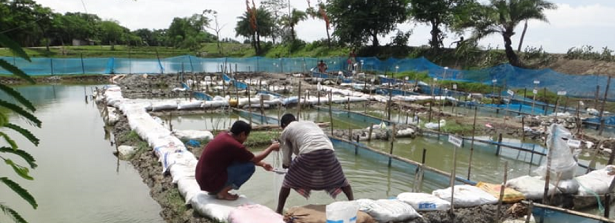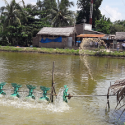Reducing the need for feed

A novel aquaculture feeding concept is exploiting the pond ecosystem to encourage farmed fish and shrimp to ingest naturally occurring food alongside feed – a system that has the potential to reduce both production costs and environmental impacts. The trials for this nutritious-pond concept are part of the Global Challenges Programme project “Nutritious-system pond farming in Vietnam”.
As the global population grows, so does the demand for fish and the pressure on aquaculture to increase productivity. Enabling this increase is an expansion of fish and shellfish farming areas and an intensification of the production systems that provide roughly half of the fish and shellfish consumed worldwide.
Intensive aquaculture relies heavily on commercially produced feeds, which use significant quantities of aquatic resources, such as fishmeal and fish oil, as well as terrestrial supplies such as cereals and pulses.
At present, aquaculture feeding systems generally target the cultured animals without considering the possible contribution of the pond ecosystem and its food web to the animals’ diet.
In these systems, the food web – the food chain within the pond from phytoplankton, microbes and other organisms through to the fish or shrimp being farmed – is stimulated by feed leftovers and wastes. These organisms in turn produce food for the fish or crustaceans.
However, aquaculture feed wastes do not consider the nutrient requirements of the food web, and this creates imbalance in the pond system. As a consequence, the wastes are only partially decomposed. The remainder accumulates, undermining the health of the pond environment and making it vulnerable to disease.
Many fish farmers address the problems that result from nutrient imbalances in aquaculture feed wastes by using disinfectants, mineral mixes, prebiotics and probiotics. In contrast, the “nutritious pond” concept aims to feed the fish or shrimp while also producing balanced wastes that are easily decomposed. As a result, waste accumulation is minimised, mineralisation is fast, the production of natural foods for the fish and shrimp is optimal and the pond environment stays clean and healthy.
At present, nutritious-pond feeds focus on optimising carbon-to-nitrogen ratios to accelerate the mineralisation of waste. Another advantage of using them is that carbon-rich ingredients are cheaper than nitrogen-rich ones, which reduces feeding costs.
Successful trials
The nutritious-pond concept is being trialled with whiteleg shrimp (Penaeus vannamei) in Vietnam and Nile tilapia (Oreochromis niloticus) in Bangladesh. The work is part of a five-year research project led by Wageningen University in the Netherlands in partnership with WorldFish, an international non-profit research organisation based in Malaysia.
In Vietnam’s Mekong Delta, iterative experiments over three years showed that a 20 percent reduction of the feed load, combined with additional cheap carbohydrate, achieved a similar yield to conventional shrimp-culture practices, while reducing operational costs by about 10 percent. On-farm trials showed higher individual growth per day in trial ponds compared to control ponds.
“In all the on-farm trials using this approach, ponds displayed more stable water quality and less vulnerability to disease outbreaks than a conventional feeding approach,” says Olivier Joffre, scientist at WorldFish.
Source: The Fish Site






